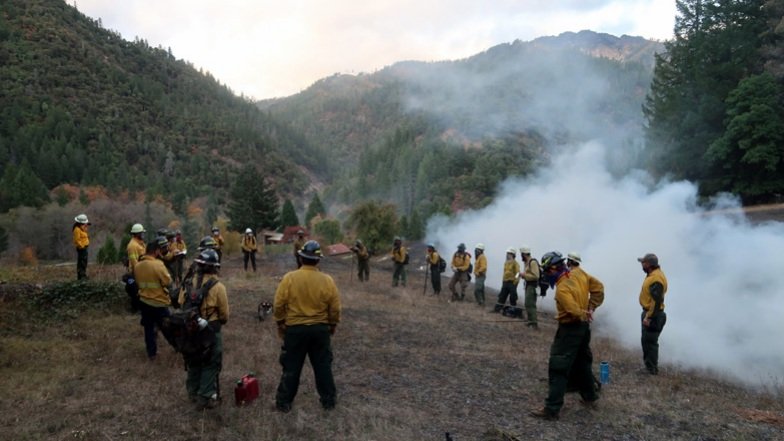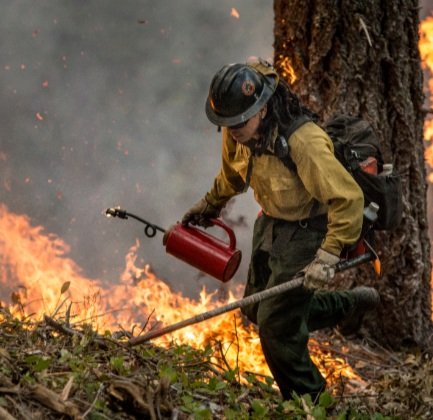
Building a Tender Box: A Renewal of Cultural Burning
Cultural burns are central to the restoration and protection of our shared land and waterscapes. The Native-led Traditional Ecological Inquiry Program (TEIP) rebuilds our relationships with each other, the land, and fire by amplifying Indigenous voices and traditional ecological knowledge in environmental education and stewardship.

Good Fire II: Current Barriers to the Expansion of Cultural Burning and Prescribed Fire in California and Recommended Solutions
Humans once experienced an intimate relationship with fire. In some parts of the world—such as within Karuk Tribal Lands—this connection remains unbroken. In North America, widespread Indigenous fire use shaped forests and grasslands, leading to greater biological diversity and healthy watersheds while also mitigating impacts from wildfire and climate variability.

Northwest Forest Plan Amendment: Categories of Focus
With the initial round of public comments and meetings amongst the FAC coming to a close, the focus of the upcoming NWFP amendment will be honing in on protections for old-growth forests, tribal inclusion, and fire resilience. It is clear that current policies that aim to suppress fire have failed to protect native old-growth forest ecosystems, as fire suppression has resulted in uncontrollable wildfires. Old-growth forest ecosystems are one of the planet’s biggest carbon sinks and offer a natural solution to the climate crisis. Logging is one of the region's largest sources of carbon emissions. The NWFP amendment needs to protect forests from commercial logging that removes the most carbon-rich, fire-resilient trees.

Indigenous Cultural Burning Crew Returns Good Fire to Oregons Willamette Valley
“As a thirty-plus year veteran of wildland firefighting and retired Fire Management Officer for one of California's eighteen National Forests, I have had the privilege of working with many incredible fire crews over the years. But I must say, the crew of young wildland firefighters I had the opportunity to work with this past fall was truly exceptional.

Wildfire Guidelines for Archaeologists (USFS)
This document briefly synthesizes some of the technical information available on the effects of fire on cultural resources. This synthesis should assist cultural resource specialists with their contributions to fire management planning, compliance for prescribed fire projects, and participation in wildland fire use or wildfire events.

Good Fire: Current Barriers to the Expansion of Cultural Burning and Prescribed Fire in California and Recommended Solutions
In 2020, over four percent of California burned in wildfire. Over 30 people lost their lives in the fires; experts estimate an additional 3,000 premature deaths may have resulted from wildfire smoke. Property damage is expected to top $10 billion.

Don’t stop or shop, until you drop
“Permission has been given to use one blade wide dozer lines in the wilderness.”

Native Forests Need Native Fires
This is a transcript of a speech that was given at the "Traditional Fire Use and the National Fire Plan Conference" hosted by the Confederated Tribes of the Grand Ronde and the Confederated Tribes of Siletz Indians, Grand Ronde, Oregon, on June 12, 2002.

10 Ways that the Climate Crisis, Wildfires and Militarism are Intertwined
The war on wildland fire is simply an extension of our country’s extreme militarism – a place where veterans of foreign wars, wanna-be cops, and other conservative-minded men, mostly, can assemble, bond, and wrap themselves in a narrative of strength, heroism and sacrifice. There is a place for men and women to suppress fires near homes and vulnerable infrastructure. However, claiming glorious victory when fires are easiest to suppress, go out on their own, or when a break in the weather moderates conditions is disingenuous.

Spotlight: FUSEE Board Members
Firefighters United for Safety, Ethics, and Ecology would like to welcome its two newest Board Members, Bill Tripp and Taro Pusina.

Carr Fire CATlines: The Environmental Impacts of Bulldozers in Wildfire Suppression
Bulldozer firelines or "CATlines" cause extensive, lasting environmental damage and destroy Native American heritage sites. In the era of climate change, they are rapidly becoming ineffective in stopping wildfire spread during severe weather conditions. The 2018 Carr Fire offers a case study for the kinds of damage caused by catlines whose scars still remain on the landscape.

Fire as Medicine: Fire-Dependent Cultures and Re-Empowering American Indians Tribes
Across North America, many communities seek to live more safely with wildland fire; some call that working to become a fire adapted community. Many American Indian tribes were historically able to live within fire-prone ecosystems, but rather than just being fire adapted, they were and still are fire dependent cultures.

Field Guide for Archaeologists Assigned to Wildfires (BLM)
The main objective of this volume is to define cultural resources, provide information about the mechanisms that affect cultural resources, and identify management alternatives to prevent (or limit) adverse impacts within the proper legal framework.

Guide to Fire Effects on Cultural Resources (BLM)
This document briefly synthesizes some of the technical information available on the effects of fire on cultural resources. This synthesis should assist cultural resource specialists with their contributions to fire management planning, compliance for prescribed fire projects, and participation in wildland fire use or wildfire events.
